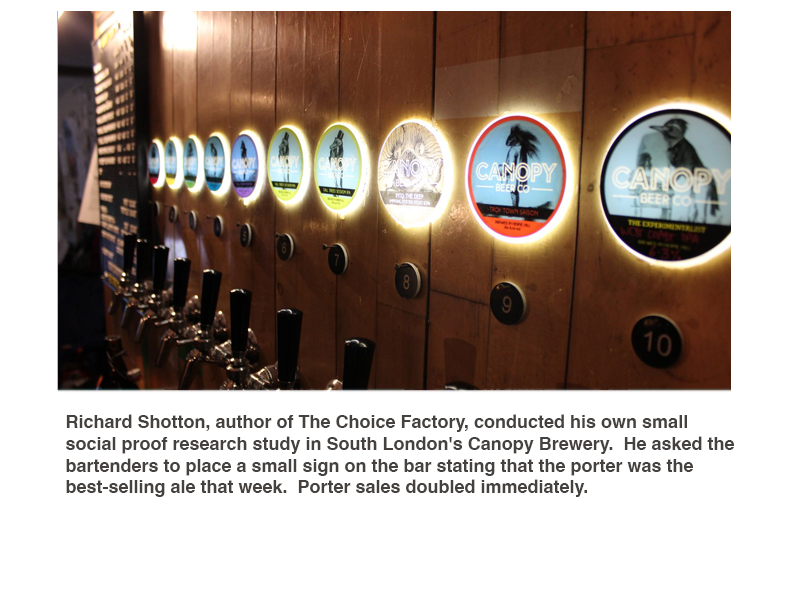Think you're your own person? That you make most decisions based upon a conscious and thoughtful evaluation of the options? Think again. Every single day, both in the online world and in the physical world, other people influence how we act, what we do, and what we buy. In fact, what other people say, think and do is one of the most powerful motivators we experience.
It's a social and psychological phenomenon called social proof, also known as “informational social influence.” It simply means that people tend to conform in order to be liked by, similar to, or accepted by the influencer or society. It also explains why songs become hits, why companies thrive or die from reviews, and why popularity comes and goes in waves.
It's a widely accepted rule that no one really talks about but everybody follows: "If everyone else is doing it/saying it/buying it, I should too." As amazing as the human brain is, it's also pretty lazy. Think of social proof as a decision making hack; it’s faster and easier to follow the crowd than to think through all the pros and cons of every decision.
“The five most dangerous words in business are: ‘Everybody else is doing it.'” —Warren Buffett
Throughout evolution, social proof has increased our chances of survival. Following the herd was safer than braving the tundra alone. In caveman times, if you saw a neighbor caveman running for his life, you'd assume he was in danger and you'd most likely follow him. Today, social proof means belonging to an “in-group.” Since we are social beings, being “left out” doesn’t feel good and doesn’t meet our basic needs for belonging.
But today, social proof shows up in every aspect of our lives, and it's not always the most reliable way to make decisions. Perhaps the oldest and most famous study on social conformity is the Asch experiments - a series of studies published in the 1950s. The subject is told he is taking part in a visual perception test. What he doesn’t know is that the other participants are actors instructed to give incorrect answers. Before long, the volunteer is also giving incorrect answers even though it is clear that he knows the answers are incorrect.
Social proof is most influential under three conditions:
- Uncertainty: When people are uncertain as to how to act or what to do, they accept the actions of other as correct.
- Popularity: People are more likely to follow the lead of others in proportion to the others' number. The more people we see saying it/doing it/buying it, the more socially acceptable and desirable it becomes.
- Similarity: People conform to the behaviors of those they perceive to be "people like me."
A Powerful Influence on Human Behavior
When you see testimonial on a website from an industry expert you respect, that’s social proof. When you’re browsing an online product page and see how many others have purchased that particular item, that's social proof. When you see a friend's review of a new restaurant on Facebook, that's social proof. Social proof is the main reason why some night clubs make people wait outside so people walking by will notice the long line and wonder "what's going on in there?"
Social proof influences our behavior like our decisions to recycle, where to eat, and how fast to drive on the highway. If the speed limit is 70 mph but everyone is flying past you clocking 80, you're more likely to speed up.If the neighborhood is dotted with green recycle bins on trash day, more people will make a conscious effort to recycle. If there are no stray shopping carts in the grocery store parking lot, chances are good that we'll return our cart to the corral. Conversely, if carts are strewn about the lot, we're more likely to abandon ours in place.
Psychology professor and author, Robert Cialdini, has explored this phenomenon extensively. In one study, his team tested messages to influence reusing towels in hotel rooms. When guests were presented with the message – “Almost 75% of other guests help by using their towels more than once” they increased reuse by 25%. What is even more fascinating is that adding the words “of other guests that stayed in this room” (people like me) had even more impact.
“We are willing to place an enormous amount of trust in the collective knowledge of the crowd...Social Proof is most powerful for those who feel unfamiliar or unsure in a specific situation and who, consequently, must look outside themselves for evidence of how best to behave.” - Robert Cialdini, Influence
Popularity Precipitates Popularity
Social proof also influences our consumer decisions. You see two restaurants - one empty and the other busy. You're much more likely to dine at the busier restaurant even if you know nothing about either place.

You're also more likely to choose dishes that are "popular" or "house favorites." In a 2009 study, restaurant managers partnered with researchers to determine whether they could get customers to choose dishes more frequently without lowering the prices, changing the recipes or writing more enticing descriptions. Instead, they wanted to see if they could use social proof to increase the purchase of specific menu items. When they labeled the dishes "most popular," sales increased by and average of 13%-20%. Simply stated, the dishes became more popular because they were popular.


It makes sense that the words "most popular," "best-selling," and "customers' favorites" would influence your purchase decisions. Think of this label as shorthand for "lots of positive reviews." When shopping for a new product or service, you're much more likely to trust the customer who's already used the product or service. Getting a real-life opinion from someone is always more helpful, because it’s both unbiased, and often rooted in a common experience.
- 88% of consumers trust user reviews as much as personal recommendations.
- The average consumer reads 10 online reviews before making a purchase decision.
- 57% of consumers will only buy or use a business service if it has at least a 4-star rating.
- 50% of all consumers will visit a company or product website immediately after reading a positive review about them.
Check out this Hyundai ad that cleverly combines social proof with the frequency bias (a cognitive bias in which, after noticing something for the first time, there is a tendency to notice it more often, leading someone to believe that it has a high frequency of occurrence). The use of the word "also" implies that you're one of many other people who have noticed more Hyundais on the road. In addition, by phrasing the message as a question, it increases the suggestive nature and increases our receptiveness to notice them. Every time you see a Hyundai, you'll think, "Wow... they really ARE everywhere!"

The Scarcity Effect
Social proof and scarcity are close cousins. The scarcity effect is a cognitive bias whereby we tend to place a higher value on things that are scarce and a lower value on things that are more readily available. We associate scarcity with luxury and exclusivity. We often inaccurately assume that something is scarce because everyone wants it or already has it. In other words, scarce objects arouse our interests and so immediately become more desirable than a product that is readily available. The most common examples are travel deals. You’ve seen these buttons that make you want to hurry up and grab the last one vacation package.

Kurt Geiger is a leading London-based footware and accessories company. Since 2019, their e-commerce team has used both social proof and scarcity to increase sales. For example, right on the product page, they tell you how many people have added the item to their bags in the last 24 hours. In addition, they make sure you know the item is trending – everyone is buying this... what are you waiting for?!

Negative Social Proof
No matter how flat you make a pancake, there are always two sides. Social proof can create undesired results, too. In a rather famous study on negative social proof, Dr. Noah Goldstein and his colleagues were trying to get visitors to stop stealing petrified wood from a national park. They experimented with two tactics. A positive social proof sign: “Please don’t remove the petrified wood from the park, in order to preserve the natural state of the Petrified Forest.” And a negative social proof sign: “Many past visitors have removed the petrified wood from the park, changing the natural state of the Petrified Forest.”
The result: The negative sign tripled theft.








